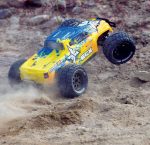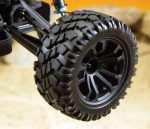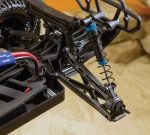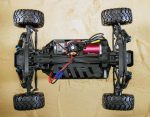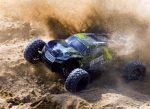Fun for All!
This article was originally published in RC Driver’s February 2016 issue.
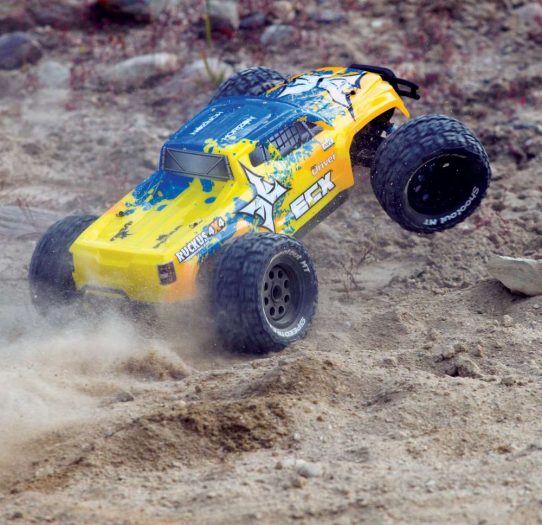
Words: David Harrington
Photos: Edwin Rodriguez
Horizon Hobby has some of the best customer service in the business. I have dealt with them and they always go the extra mile to make the customer happy. I think it is because they work so closely with their customers that they realized the need for an RC that provides the first-time buyer with an easy transition into this hobby. That’s where the ECX brand comes in. The RCs in the ECX line are all-inclusive, durable, fun RCs that are sure to get the first timer hooked. The two that I’m looking at here, the Circuit stadium truck and its big brother, the Ruckus monster truck, are both four wheel drive vehicles that come with brushless systems. The problem with brushless and beginner friendly is that these cars actually take some skill to drive and not all first time drivers are ready for brushless speed and power, which leads to crashes and frustrations. However, these two RCs are equipped with Spektrum’s AVC technology which actually helps drive the car. Often this kind of technology makes me feel limited. So it will be interesting to see if this AVC technology can actually help make a beginner a better driver, while still allowing them the thrill of a brushless vehicle. Read on and we shall see!
WHO IT’S FOR: Beginner to Intermediate
PART NUMBER: Circuit: ECX0311 Ruckus: ECX03016
HOW MUCH: Circuit: $239 Ruckus: $329
BUILD TYPE: RTR
REVIEWER’S OPINION
These cars are both tons of fun. The Circuit is more precise handling and the tires are more suited to all surfaces, from dirt to concrete. The Ruckus is bigger, more stable, a little faster and more powerful with the 8.4V battery, but I felt is was more difficult to keep under control. The AVC is great for beginners and it actually helped my driving, without feeling too obtrusive. Overall a great way to get started!
• AVC really helps the first time driver and me, too
• Water resistant electronics
• Powerful brushless system
• All-inclusive package
• Durable composites
• Enclosed drivetrain
• Pivot ball front end
CONS
• I’m not a fan of wall chargers
• The Ruckus needs a more powerful servo in order for the AVC to work correctly
TOOLS AND ACCESSORIES INCLUDED
• Bind plug
• Preload clips
ITEMS NEEDED
• Nothing, everything included!
ITEMS USED
• I cheated and used my fast charger: Dynamite 100w charger, DYNC3000, $109.99
HOP-UPS WE RECOMMEND
• Dynamite 7.4V 4000mAh 30C Lip battery, DYN9003, $39.99 This will really wake up the brushless system. Get a few and run all day!
• Dynamite Prophet 80W Charger, DYNC2015, $69.99 This is a good budget priced charger, that gets you going with those LiPo batteries.
• Spektrum High Torque Metal Gear Servo, SPMSS6020, $39.99 The Ruckus needs a servo with more torque. The Circuit could benefit from it as well.
 FEATURE BREAKDOWN
FEATURE BREAKDOWN
The chassis of these two trucks are nearly identical. The two differences are that the Ruckus has a longer wheelbase, similar to a short course truck, and large bumpers that extend from the chassis. The Circuit’s chassis is true to 1/10-scale in length and has racier skids replacing the bumpers. The tub chassis is made of a rigid composite. The center channel that houses the center driveshaft has raised sides that meet up with the upper brace to almost completely enclose the driveline. The only opening is where the steering draglink passes through the sides. This for an overall stiff chassis that contributes to good handling.
The suspension is identical on these two trucks. They both have parts made of a softer, almost rubbery composite that gives the parts some give and makes it extremely durable. The front end rides on pivot balls for super smooth steering. The rear uses more traditional A-arms with fixed upper links. Both trucks have extremely long travel shocks which do great at soaking up the roughest terrain.
The driveline is where these trucks really shine. The front and rear use durable steel gear diffs, which are sealed and can be tuned with fluids. The front also uses steel CV type driveshafts, to ensure smooth power delivery, even when the wheels are cranked to one side. The rear uses stout dogbones. The center driveshaft is aluminum, to minimize rotational mass and make throttle control more responsive. The only difference between the two is the Ruckus has a longer shaft to accommodate the longer wheelbase.
The Spektrum radio that is included seems pretty standard to an RTR package, with just the basic adjustments and analog trims, but not only does it use Spektrum’s ultra-reliable DSMX technology, these trucks also come with the AVC capable receiver. That’s probably the main selling point of these vehicles, as I was actually amazed just how well it worked!
The Dynamite Tazer brushless system will give you all the speed and power you will ever want. It is good, smooth system. The 4-pole motor must be very efficient, because most 4-pole motors that I’ve encountered are power hogs that require a LiPo with a high C rating. Not this system, it ran just great with the included NiMH batteries. The SC does have LiPo cutoff, making it 2S LiPo compatible.
The included NiMH batteries seem to be of very good quality for NiMH cells. These kinds of batteries would normally starve a brushless system, as I mentioned, but both cars had plenty of kick. The runtime defied the 3300mAh capacity rating. I was out playing for well over 18-25 minutes of stop/start driving. The difference between the two here is the Ruckus has a longer chassis which allows for the 7- cell 8.4V battery, whereas the Circuit has a 6-cell 7.2 V battery. In the past I have seen ECX include a fast charger with their kits. I have to admit that while I appreciate they had to keep it cost effective with the brushless system and AVC included, I’m not a fan of the included wall charger, which can take up to 12 hours to charge the batteries. However, I had to wait two weeks until next payday to buy a fast charger so it would have been nice if they included one.
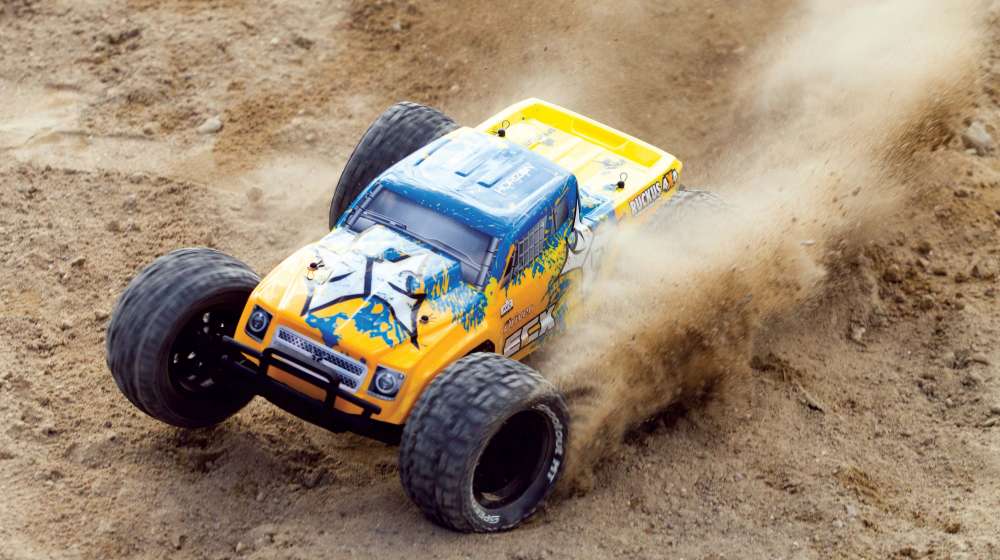
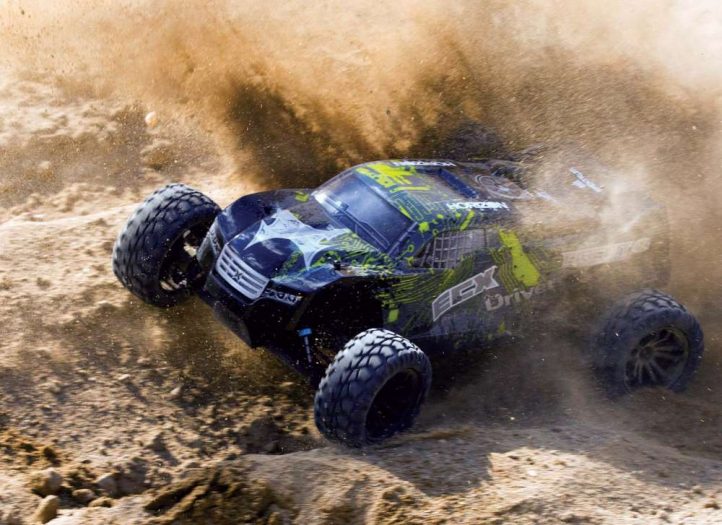
ON THE TRACK
Someday I plan to build a backyard track at my new place, but as it is, recent storms have made a mess of things and I’ve barely kept up on yard work. So the new RCs inspired me to go out with a shovel and dig out some weeds, which made my wife happy. After raking up debris and sweeping some dirt, I cut up the large cardboard box the cars were shipped in to make two wedge-shaped ramps. I found a piece of wood just wide enough for the cars and propped that against my porch, which is raised up about a foot and a half, to make a ramp up. Now I had a makeshift track to drive on and by this time both batteries were topped off. I started with the Circuit. When I went to put it on the ground I noticed the front wheels were turned to one side. I thought I needed to adjust the steering trim, but when I raised it back up the wheels turned the other direction. I then realized that was the AVC at work. I thought, I don’t want it driving for me, so I turned that knob all the way back. I blasted toward the first jump and it caught some big air! I was a bit surprised how high it jumped at first, but it came off slightly nose high with a slight arc to to it, so the front was just starting to come down when it hit ground. I whipped it around a 270 degree turn to get pointed at the ramp to get up on the porch. I would have liked a tighter turning radius, but I was able to get the rear to slide around a bit to tighten it up. Up on the porch, the all-terrain tires hooked on the slick concrete as well as the dirt. Dropping off the porch into a 90-degree turn to hit the next ramp proved to be tricky. I had to come off with speed, but since it needed time to settle in and gain traction after the drop, too much speed would send me sliding sideways into the shed. Over the next ramp, more big air, even with the short run-up. Down the stretch to the side of the house, and a 180 around the garbage can lid. This part is still covered in loose gravel so it was like driving on marbles, difficult to get around the tight corner without spinning out. So I decided it was time to crank up the AVC and see what it does. To my surprise, it was not obtrusive. I still felt like I was driving the car. I could slide the rear a bit, but if I tried to get out of control or do donuts, it refused. Now when I dropped off the porch, I was able to cut it tight and hit the ramp straight on. No more spinning out in the gravel. It really works!
Next up was the Ruckus. The Ruckus uses the same servo as the Circuit, but has much larger wheels to turn. The longer wheelbase also diminishes the steering radius, so it seemed a bit sluggish to turn. Once I got lined up on the jump I nailed it and I thought the larger tires would hook up better, but it got a bit squirrelly. I actually think they hooked up well, but the extra power from the 8.4V battery is what was breaking the tires free because it was noticeably faster and more powerful than the Circuit. I hit the jump and this thing flew! Actually it scared me because I thought I was going to take myself out. The rotational mass from the larger tires made it more responsive to throttle input in the air. I tried the AVC on this one and it seemed to actually have a reverse effect. I was confused at first, but then realized it was because the servo couldn’t keep up with the AVC. I dialed the AVC back to about 30%, and then I started to see some improvement. I decided to get my son out to play with me. My son has autism and because of that, if something doesn’t come easily to him, he doesn’t want to do it, which is why I think he never took to RCs. I was curious to see if the AVC would help him. He will never admit to enjoying anything, but I looked over a couple of times and actually saw him smirking. He was having fun whether he’ll admit it or not. I asked him which he liked better, assuming he would say the Circuit because I felt it was easier to drive, but he said he liked the Ruckus better, because he didn’t have to flip it over all the time. Makes sense, the longer wheelbase will be more stable. Proving there is no best, just best for you.
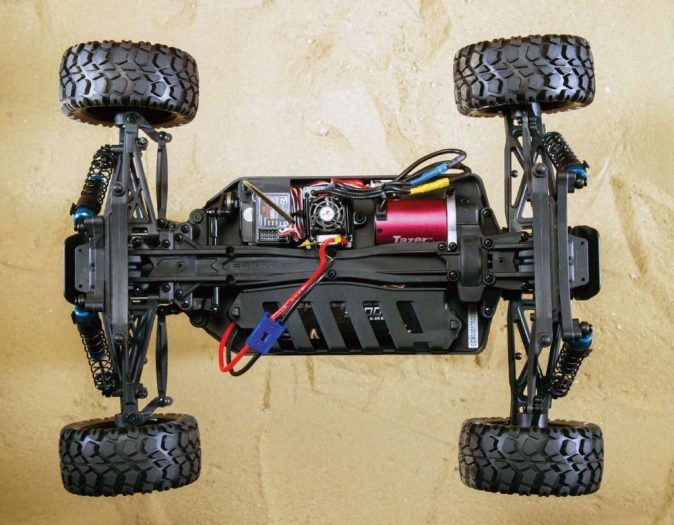
for in-depth reviews on the latest RC vehicles
SPECS AND TUNING OPTIONS
DIMENSIONS
Length: Circuit 16.7 in. (424mm )
Ruckus: 20 in. (508mm)
Width: C: 13.3 in. (337mm) R: 13.5 in. (334mm)
Wheelbase: C: 11.6 in. (295mm) R: 13.2 in. (333mm)
Weight: C: 4.97lbs (2300kg) R: 6.45lbs (2920kg
BODY, WHEELS AND TIRES
Body: C: Stadium truck R: Monster truck
Wheels: C: 2.8 in. split 5-spoke R: 2.8 in. 8-hole
Wheel adapter type: 12mm hex
Tires: C: Low profile all terrain block R: Tall and wide off road tread
SUSPENSION
Type: 4-wheel independent
Shock positions: (F) 3-tower, 2-arm (R) 3-tower, 2-arm
Camber: N/A Roll: N/A
Wheelbase: N/A
Ride height: Preload clips
Misc: Front pivot balls
STEERING
Type: Dual bellcrank
Toe: N/A
CHASSIS
Type: Tub
Material: Composite
Thickness: Varying
DRIVETRAIN
Type: 4WD
Transmission: Center slipper
Differentials: Steel gear
Clutch Type: Dual pad slipper
Gear ratio: Optional pinion gears
Bearings: Full set of shielded
RATING TALLY
Opinion: 9
Acceleration: 9
Steering: 6
Handling: 8
Durability: 9
Feature Breakdown: 9
Overall Value: 9
WRAP UP
I had previously driven the brushed version of the Circuit and thought it was good for beginners, but a little underpowered. Now with the brushless version of these two trucks, I had plenty of speed and power to keep me entertained. With the inclusion of Spektrum’s AVC, that power was super easy to control. After all these years, this was the first time I saw my son truly have fun with an RC and not get frustrated because he couldn’t control it. Give a first-time driver an RC as fast as these that they can actually control it, they’re going to be hooked!
LINKS
Horizon Hobby, horizonhobby.com
 RC Driver The Best In RC Car & Truck News, Reviews & Video
RC Driver The Best In RC Car & Truck News, Reviews & Video 


